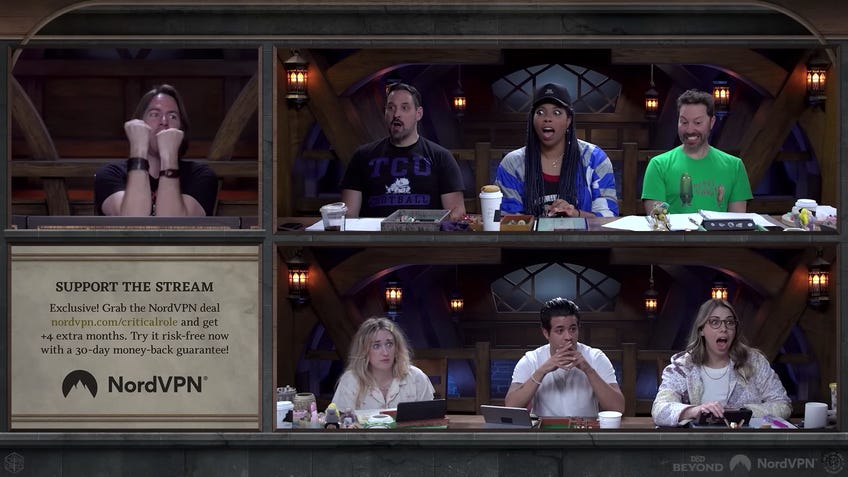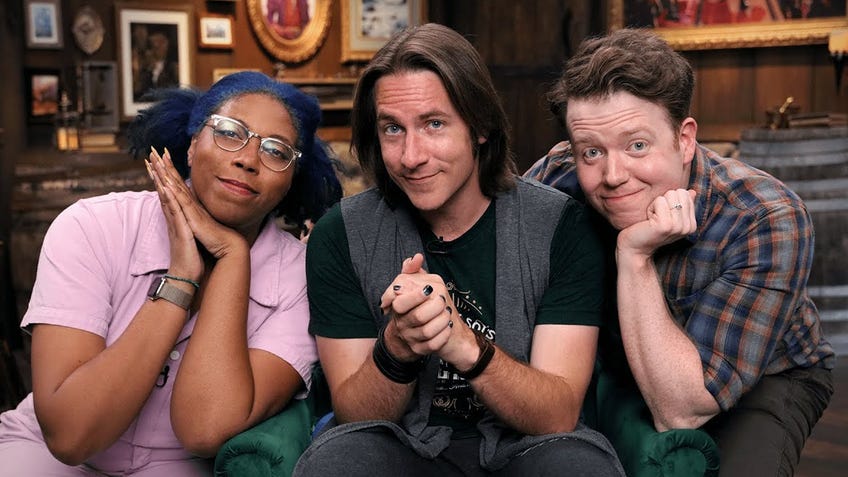Is Critical Role’s Campaign 3 the end of Exandria?
Signs point to Campaign 3 being the last, at least with the Critical Role cast we’re used to.
Critical Role could be approaching an incredible milestone – the end of Exandria’s fantasy world as we know it.
Warning: huge spoilers for Critical Role Campaign 3 ahead.
That may seem hyperbolic, but in a D&D actual play where the apocalypse is threatened every few weeks, it’s fitting to consider how the beloved stream may be approaching some kind of conclusion, after which nothing will be the same.
We’re now almost 60 episodes into Critical Role Campaign 3, which suggests we’re nearing the halfway point of this particular story. (The first two campaigns reached 115 and 141 episodes respectively.) But so much about this campaign points towards the end of not just Bells Hells’ adventures, but also the trilogy of campaigns itself.
Whereas Critical Role Campaign 2 clearly carved out its own identity, only occasionally connecting with the characters of the original Vox Machina story, Campaign 3 has felt very different. Much of the party consists of either characters from past streams (Fearne, Orym and Robbie from Exandia Unlimited: The Crown Keepers) or those connected in some way to the first campaign, with a footsoldier of Marisha Ray’s arch-druid Keyleth and an undead peasant girl once hanged in the city of Whitestone.
Episodes 35 through 51 offered a breathless series of cameos, including most of the Campaign 1 player party (Keyleth, Vex, Percy, Pike) as well as their recurring antagonist Delilah, before showing off two members of the second campaign’s Mighty Nein (Caleb, Beau) and a shocking entrance from Vox Machina’s Champion of the Raven Queen, Vax.
There’s plenty of evidence that Campaign 3 is being structured as the fitting end of a trilogy, tying together past heroes, villains and story threads for an impactful finish.
Meanwhile, C3’s wizard antagonist Ludinus Da’leth first appeared in an early episode of Campaign 2, and has been haunting the key events of Critical Role ever since – now coming to the fore with world-changing, world-ending machinations like releasing a god-eater named Predathos into Exandria.
There’s plenty of evidence, then, that Campaign 3 is being structured as the fitting end of a trilogy, tying together past heroes, villains and story threads for an impactful finish. But there are other signs that we’re heading towards the end of Critical Role as we know it.

Each campaign has gotten progressively deadlier, and Campaign 3 takes this to extremes, with resurrection magic being rendered inert by Ludinus’ actions across Exandria.
Spells like Revivify or True Resurrection can usually trivialise death in D&D, bringing back characters after they’ve technically been killed off; given we’ve already seen one character death in the party, and seemed very close to a total party wipeout at points, it’s a limitation that could see Bells Hells’ story come to end much sooner than expected. (The D&D movie had a very similar conceit with its Red Wizard Dagger, to ensure some actual dramatic stakes.)
While we don’t yet know the full impact of god-killer Predathos, or the Reilora moon people now stepping foot onto Exandria, we’ve seen gods distancing themselves from the world in recent episodes, unnerving Clerics and the main party alike. World-ending threats are part and parcel of playing Dungeons & Dragons, but a possible end to the gods themselves - or at least a massive shake-up to the divine status quo - would be a real high note to end on.
Matthew Mercer has, in the past, commented on a desire to pass on the reins for Critical Role’s primary campaign, restarting a home game with his friends and letting someone else take the central seat for the series’ weekly streams.
The past couple of years have seen a lot more experimentation and fluidity around the table composition: we’ve had Aabria Iyengar helm an EXU mini-series and bank heist two-shot, while Brennan Lee Mulligan, star DM of Dimension 20, ran a dazzling Critical Role prequel series. There’s a growing push to show alternative faces in the DM seat, and set up a Critical Role universe that doesn’t rely on a singular dungeon master running games every week for its long-term survival.
This feels like a finale in many different ways, with a drawn-out story, god-ending stakes and the conclusion of character arcs many years in the making.
The recent announcement of Candela Obscura, a new Critical Role story using a non-D&D system, is only further proof of CR expanding its horizons, and putting less emphasis on the Dungeons & Dragons stream that launched it.
Campaign 3 has also been the most spaced-out series to date, with three episodes a month instead of the weekly cadence established in past campaigns – helping to drag out the story for far longer than the two to three years of campaigns 1 and 2. At this rate, C3 could carry on well into 2025, making it the longest Critical Role campaign yet.

This feels like a finale in many different ways, with a drawn-out story, god-ending stakes and the conclusion of character arcs many years in the making. But C3 also seems to be tying up one chapter to make room for another – whether it’s a campaign fronted by another DM in the ashes of the Mercer Trilogy, or a more flexible array of shorter stories taking place in Exandria, some with Mercer and the core cast, some without.
Critical Role is no longer just a D&D podcast – it’s a multimedia franchise with hit TV shows on Amazon Prime Video, tie-in comic books, a board game publishing arm under Darrington Press and a charitable foundation that funds schools, cancer research and disadvantaged demographics. It’s become a lot bigger than a home game for Matthew Mercer and seven of his friends. It may be time for them to close this chapter on Critical Role, and end this version of Exandria, so another can begin.










